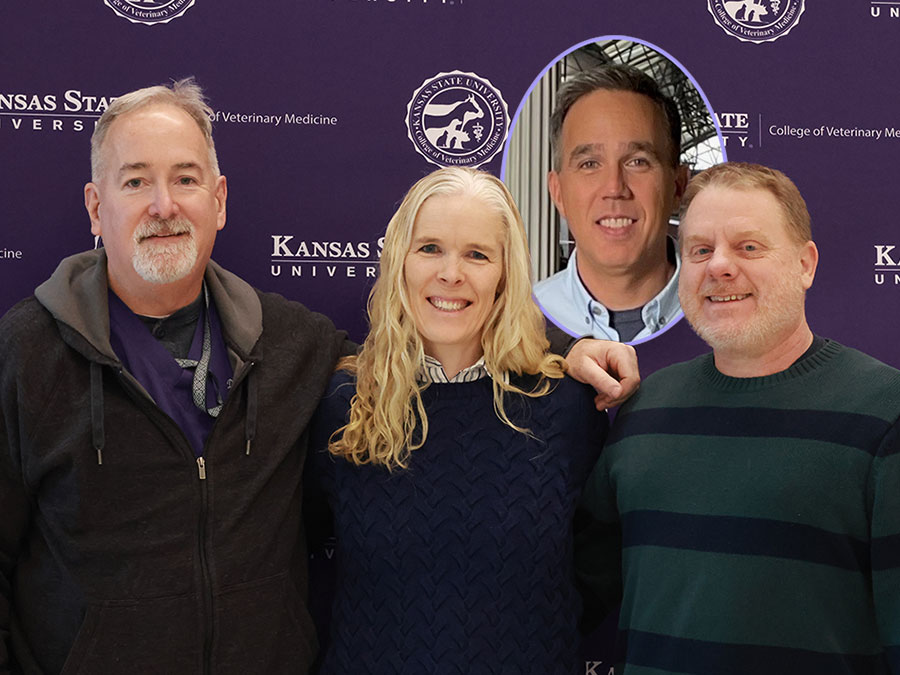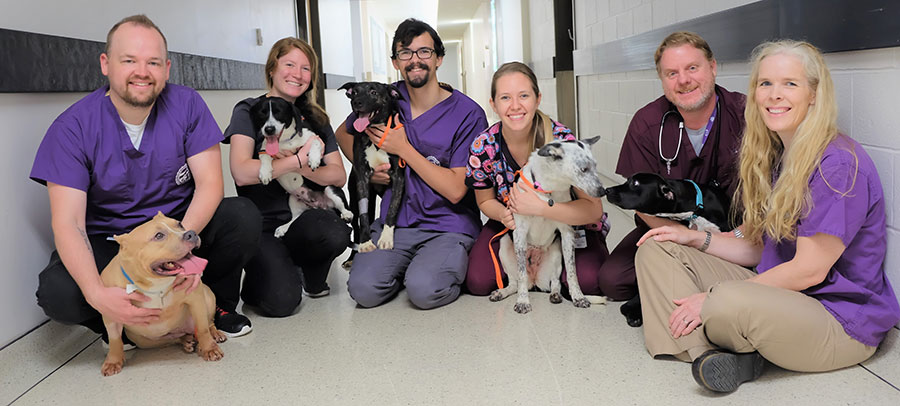Researchers receive patent for canine pain-relief formulation
As with people, animals can also suffer from different types of pain. Help is on the way, thanks to a newly patented formula developed by a veterinary team consisting of three Kansas State University researchers and a research partner previously from Vanderbilt University (now in the pharmaceutical industry).
Dr. Butch KuKanich, professor of pharmacology, Dr. Kate KuKanich, professor of small animal internal medicine, Dr. David Rankin, clinical professor and head of veterinary anesthesiology, and Dr. Charles Locuson, who currently serves as a director of drug metabolism and pharmacokinetics, or DMPK, at Agios Pharmaceuticals, received notice of their patent toward the end of 2023.

Three K-Staters plus one external collaborator: From left: Drs. David Rankin, Kate KuKanich and Butch KuKanich. Inset: Charles Locuson.
“We’ve developed a treatment that combines an opioid, methadone, with another drug, to enhance the efficacy and duration of oral methadone,” Dr. Butch KuKanich said. “The additional incorporation of an opioid abuse/misuse deterrent, naltrexone, maintains the desirable analgesic effects in dogs, while also acting to minimize the potential for opioid abuse, misuse or diversions by humans. This is also the first oral opioid formulation to demonstrate consistent clinical analgesia in postoperative dogs with effects occurring within an hour. Another huge advantage of our patented formulation is that it is effective with just two doses a day.”
Dr. Locuson said it is uncommon to develop a drug combination where the sole purpose of one drug is to improve the duration of the other. “When you deliver two drugs together, one plus one does not always equal two,” he said. “You have to work through every aspect of pharmacotherapy - dosing and disposition, but also pharmacology and safety. We started with a known analgesic we believe has untapped potential in veterinary medicine, so that simplified things somewhat. Then we improved its utility in a novel formulation.”
“Based on our successful clinical trials, we believe there is potential widespread use in dogs for perioperative patients including inpatients and outpatients,” Dr. Butch KuKanich said. “We have additionally developed a long-acting injectable formulation for use in dogs when oral administration is not desirable and have even demonstrated the use of the injectable formulation followed by the oral formulation.”

Dr. Butch and Kate KuKanich mentored former veterinary students in 2019 on related pain-relief research projects. From left, Dr. Joshua Klutzke, DVM class of 2021, Dr. Kallie Woodruff, DVM class of 2022 and Dr. Zackery Bieberly, DVM class of 2022; and the KuKaniches.
Dr. David Rankin, a board-certified veterinary anesthesiologist and member of the team said, “There’s a real need for efficacious oral pain medication. The development of this formulation of methadone is going to help a lot of dogs, and I’m pleased to have played a role in getting it ready for patients.”
Up until now, the options for treating moderate to severe pain in dogs outside of a clinic have been very limited, according to Dr. Butch KuKanich.
“Nonsteroidal anti-inflammatory drugs, or NSAIDs, have limited efficacy for mild to moderate pain in dogs,” Dr. Butch KuKanich said. “There can be adverse effects ranging from mild to severe, including gastrointestinal injury, but less commonly NSAIDs can even cause renal failure and death.”
“The ability to provide effective pain control for our canine patients is of utmost importance in companion animal medicine,” Dr. Kate KuKanich said. “This novel opioid strategy shows great promise in helping us to treat our patients’ pain, but also addresses the larger public health concerns of minimizing opportunities for opioid abuse potential in our communities.”
Dr. Butch KuKanich added, "We would like to thank those who supported studies associated with this patent: American Veterinary Medical Foundation Susan Maylahn Pain Research Grant, Dr. Karen Hale Young Research Fund, Benjamin and Catherine Kurz Research Scholarship Veterinary Research Scholars Program and a generous donor who wishes to remain anonymous."